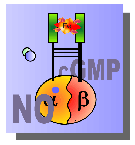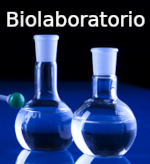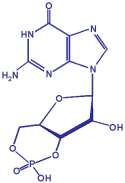
© Blauplanet.com
Other sections:





Cyclic GMP
Site
Created by Dr. Luis Agulló (last update on 28-12-2007)
Clinical Relevance of the Nitric Oxide/Cyclic GMP Pathway
Alteration of nitric oxide (NO) production and/or nitric oxide bioavailability have been shown to occur in the setting of diverse disorders as hypertension, hypercholesterolemia, aging, cigarette smoking, diabetes, erectile dysfunction, and heart failure.
Given the clinical relevance of deficiencies in nitric oxide production in several disorders, important amount of research has been devoted in order to counteract these abnormalities.
L-Arginine
L-Arginine (substrate for nitric oxide synthesis) has often been tested in experimental animals and in humans with good results in hypercholesterolemia, hypertension and diabetes. Even oral feeding of L-arginine, which only doubles plasma levels, appears to have beneficial effects.
Although in general positive, the reason for the effectiveness of the administration of this aminoacid is not completely understood. In all these clinical disorders the main alteration is supposed to occur at the endothelial level. Endothelial cells recover the interior of blood vessels and regulate nutrient exchange between plasma and tissues. In these cells, when studied in vitro, nitric oxide production is not altered by increasing L-arginine concentration. L-Arginine concentration inside the cell seems to be high enough to allow maximal activity of nitric oxide synthase (NOS) and, in addition, these cells are able to resynthesize this aminoacid from L-citrulline (co-product in the synthesis of nitric oxide).
Suggested mechanisms for this apparent paradox have been for example that an excess of L-arginine may allow nitric oxide synthesis not mediated by enzyme activity, that can occur at high concentrations of this aminoacid, or may compensate for the inhibitory effect of the endogenous inhibitor of nitric oxide synthase, asymmetric dimethyl arginine (ADMA).
Natriuretic peptides
Other substances related with this transduction pathway that have been administered with good results in patients are natriuretic factors. These compounds are endogenous peptides that activate membrane guanylyl cyclases and in consequence stimulate intracellular formation of cyclic GMP. Both nitric oxide and natriuretic peptides, through different ways (different enzymes), elicite increases in cyclic GMP synthesis.
The best known function of these peptides is their diuretic action. Apart from this renal action, natriuretic factors have important actions on the Cardiovascular System (reduce peripheral vascular resistance and lower blood pressure) and in the Central Nervous System (inhibition of vasopressin secretion and regulation of salt appetite and water drinking).
In accordance with these functions, the efficacy of natriuretic factors have been tested in disorders like hypertension, renal insufficiency, and congestive heart failure. Administration of these peptides reduces blood pressure and promotes sodium excretion in patients with essential hypertension. It also lowers blood pressure and improves central hemodynamics in patients with chronic heart failure.
Viagra
Recently, an inhibitor of one of the enzymes that degrade cyclic GMP (viagra or sildenafil, inhibitor of the cyclic nucleotide phosphodiesterase type V) has started to be amply used to treat erectile dysfunction. This compound allows that the same chemical impulses elicit much more cyclic GMP accumulation, since its degradation has been inhibited, and in consequence it improves vasodilation and final erection.
Related Web Sites
Nitric Oxide and Vasodilation [few outlines about NO with some interesting links; Rutgers, The State University of New Jersey, USA]
Nitric Oxide and Vascular Health [brief introduction to therapeutic relevance of NO and related drugs; Health and Age, Novartis Foundation]
Stress-related diseases : a potential role for nitric oxide [Esch T, Stefano GB, Fricchione GL, Benson H]
Parkinson's disease: a potential role for microglia and nitric oxide [Czlonkowska A, Kurkowska-Jastrzebska I, Czlonkowski A, Peter D, Stefano GB]
Sexual Chemistry, Questions and Answers [basic and clear introduction to erectile dysfunction; BBC]
Erectile Dysfunction [very good introduction to erectile dysfunction disease; Milton Lakin MD, The Cleveland Clinic, USA]
Erectile Dysfunction: Serious Research for a Serious Problem [the history of viagra and some hints about the new approaches to treat erectile dysfunction; The Scientist]
The Effects of Viagra on the Action of Nitric Oxide [Emory University, Georgia, USA]
What is Viagra? and How Does It Work? [introduction to the function of viagra; R J Huskey, University of Virginia]
Selected references (open access)
Cardiovascular disease
Kishimoto I, Rossi K, Garbers DL. A genetic model provides evidence that the receptor for atrial natriuretic peptide (guanylyl cyclase-A) inhibits cardiac ventricular myocyte hypertrophy. Proc Natl Acad Sci USA 27:2703 (2001). [Full Text]
Chen AF, Ren J, Miao CY. Nitric oxide synthase gene therapy for cardiovascular disease. Jpn J Pharmacol 89:327 (2002). Review. [Full Text]
Chen AF, Ren J, Miao CY. Nitric oxide synthase gene therapy for cardiovascular disease. Jpn J Pharmacol 89:327 (2002). Review. [Full Text]
Wollert KC, Fiedler B, Gambaryan S et al. Gene transfer of cGMP-dependent protein kinase I enhances the antihypertrophic effects of nitric oxide in cardiomyocytes. Hypertension 39:87 (2002). [Full Text]
Ignarro LJ. Nitric oxide as a unique signaling molecule in the vascular system: a historical overview. J Physiol Pharmacol 53:503 (2002). Review. [Full Text]
Channon KM, Guzik TJ.Mechanisms of superoxide production in human blood vessels: relationship to endothelial dysfunction, clinical and genetic risk factors. J Physiol Pharmacol 53:515 (2002). Review. [Full Text]
Egashira K. Clinical importance of endothelial function in arteriosclerosis and ischemic heart disease. Circ J 66:529 (2002). Review. [Full Text]
Holtwick R, van Eickels M, Skryabin BV et al. Pressure-independent cardiac hypertrophy in mice with cardiomyocyte-restricted inactivation of the atrial natriuretic peptide receptor guanylyl cyclase-A. J Clin Invest 111:1399 (2003). [Full Text]
Molkentin JD. A friend within the heart: natriuretic peptide receptor signaling. J Clin Invest 111:1275 (2003). [Full Text]
Diabetes
Takamura T, Kato I, Kimura N et al. Transgenic mice overexpressing type 2 nitric-oxide synthase in pancreatic beta cells develop insulin-dependent diabetes without insulitis. J Biol Chem 273: 2493 (1998). [Full Text]
Spinas GA. The Dual Role of Nitric Oxide in Islet beta-Cells. News Physiol Sci 14:49 (1999). [Full Text]
Igarashi J, Michel T. More sweetness than light? A search for the causes of diabetic vasculopathy. J Clin Invest 108:1425 (2001). [Full Text]
Johannesen J, Pie A, Pociot F et al. Linkage of the human inducible nitric oxide synthase gene to type 1 diabetes. J Clin Endocrinol Metab 86:2792 (2001). [Full Text]
Goligorsky MS, Chen J, Brodsky S. Workshop: endothelial cell dysfunction leading to diabetic nephropathy: focus on nitric oxide. Hypertension 37:744 (2001). Review. [Full Text]
Calles-Escandon J, Cipolla M. Diabetes and endothelial dysfunction: a clinical perspective. Endocr Rev 22:36 (2001). Review. [Full Text]
Du XL, Edelstein D, Dimmeler S et al. Hyperglycemia inhibits endothelial nitric oxide synthase activity by posttranslational modification at the Akt site. J Clin Invest 108:1341 (2001). [Full Text]
Neurodegeneration
Ischiropoulos H, Beckman JS. Oxidative stress and nitration in neurodegeneration: cause, effect, or association? J Clin Invest 111:163 (2003). Review. [Full Text]
Czlonkowska A, Kurkowska-Jastrzebska I, Czlonkowski A et al. Immune processes in the pathogenesis of Parkinson's disease - a potential role for microglia and nitric oxide. Med Sci Monit 8:RA165 (2002). Review. [Full Text]
Erectyl Dysfunction
Champion HC, Bivalacqua TJ, Hyman AL et al. Gene transfer of endothelial nitric oxide synthase to the penis augments erectile responses in the aged rat. Proc Natl Acad Sci USA 28:11648 (1999). [Full Text]
Hedlund P, Aszodi A, Pfeifer A et al. Erectile dysfunction in cyclic GMP-dependent kinase I-deficient mice. Proc Natl Acad Sci USA 29:2349 (2000). [Full Text]


Author: Dr. Luis Agulló (luis.agullo [at] lagullo.com).
Edited by Blauplanet.com, Cerdanyola del Vallès, Barcelona, Spain.
Webmaster: info [at] blauplanet.com. Conditions of use.